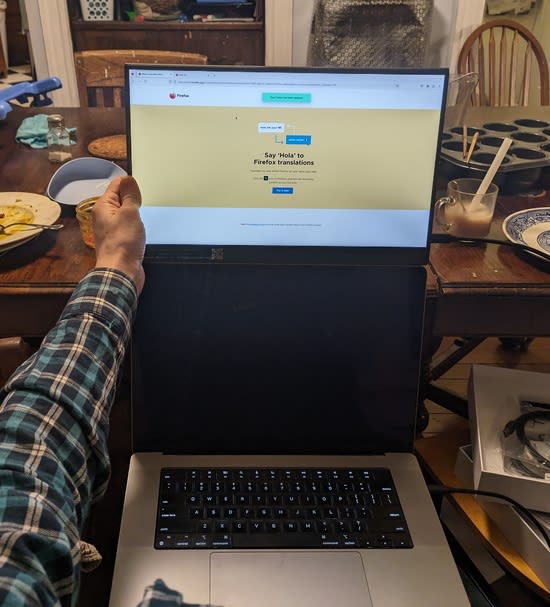Screen-supported Portable Monitor
post by jefftk (jkaufman) · 2024-01-04T13:50:06.179Z · LW · GW · 10 commentsContents
10 comments
I broke my MacBook screen a few weeks ago and it didn't end up making sense to repair it. I was considering getting a new computer, but since I almost always use an external monitor maybe a portable external monitor would work?
I found a well reviewed 15.6" one for $130, capable of 1920x1080 (1080p / FHD). It can do power and video over a single USB C cable, and if I fold the cover back it will slide over my laptop's broken screen:
The plug-and-play was pretty great: I attached the cable and it just worked! I did have to set the screen to 1920x1080 manually, though; it defaulted to 960x540:
This is nice, but really I'd like something at eye level so I don't hurt my neck looking down at the screen. Sometimes I'll be somewhere I can put the monitor up on something, but it would be nice if I could use the built-in screen for that:
It seems like it ought to be possible to make some sort of bracket, possibly 3D printed, that attaches to the portable monitor and is supported by the laptop screen? It has two VESA holes on the back for mounting and weighs 1.6lb (726g). I can't find anyone online doing this; is there a reason it wouldn't work?
Comment via: facebook, lesswrong, mastodon
10 comments
Comments sorted by top scores.
comment by bvbvbvbvbvbvbvbvbvbvbv · 2024-01-05T08:20:30.716Z · LW(p) · GW(p)
DIYPerks on youtube did just that: https://www.youtube.com/watch?v=J2aY6cvk-WI
Replies from: jkaufman↑ comment by jefftk (jkaufman) · 2024-01-05T14:59:11.534Z · LW(p) · GW(p)
Thanks for finding this! That build was a lot more DIY than what I'm doing: almost the whole video is them building things that I got essentially "for free" with the screen I chose. I think the relevant bit is they used hinges to attach the additional monitor to a metal panel the size of the laptop screen, and then velcro'd that panel to the back of the laptop screen. They used custom 3d-printed hinges, and a kickstand to support the additional weight.
I do think I want something with hinges, or else I end up with a portable monitor + adapter setup which is awkwardly large. I think I may be able to find existing hinges (a door hinge?) that have the right properties without needing to 3d print something.
Replies from: bvbvbvbvbvbvbvbvbvbvbv↑ comment by bvbvbvbvbvbvbvbvbvbvbv · 2024-01-05T16:15:19.709Z · LW(p) · GW(p)
Also, velcro comes in many strength and sizes. I find heavy duty velcros to be frequently underused in such DIY projects
comment by winstonBosan · 2024-01-04T14:14:33.738Z · LW(p) · GW(p)
It might work, but it seems like the main difficulty would be the laptop hinge.
The hinge would be taking way more force than it is intended to take. And from my experience, it is somewhere around 3kg for macbook air 13 (your model is likely different) - so a M156 mounted 35cm above the hinge might produce quite a bit of stress.
Replies from: jkaufman↑ comment by jefftk (jkaufman) · 2024-01-04T14:17:01.422Z · LW(p) · GW(p)
I see people doing this with side monitors (ex) but possibly these all have kickstands?
Replies from: winstonBosan↑ comment by winstonBosan · 2024-01-04T14:23:37.099Z · LW(p) · GW(p)
Indeed! But these are side loads instead of directly above the hinges.
Imagine this... you are a hinge. You are designed to take loads that roughly matches the motion of opening and closing of the lid + a bit of additional tolerance. But when someone mounts something heavy on the side of the laptop, you are mostly annoyed but OK with it because the side load will try to rip out the hinges out of their respective housing in different directions - the housing is usually plastic on cheaper computers, but perhaps aluminum on macs?
The problem with have that much weight on the top of your laptop would be... that your hinges would want to close when you don't want them to - they not designed to be stable while holding onto that much weight + the leverage given to the new screen from being far away from the hinge assembly.
↑ comment by jefftk (jkaufman) · 2024-01-04T14:51:17.402Z · LW(p) · GW(p)
I'm imagining positioning this so that it's vertical and balanced, and isn't loading the hinge very much towards either opening further or closing?
Consider that it's designed to hold the normal-weight screen in whatever position you leave it, including the maximum-leverage nearly-closed position, and it seems like it should be able to handle a somewhat heavier weight when close to the ideal angle?
Replies from: winstonBosan↑ comment by winstonBosan · 2024-01-04T15:23:07.252Z · LW(p) · GW(p)
It is very possible that it works - though I am somewhat doubtful and I don’t have a unit to test it.
A quick way for us to learn more would be to I guess duct tape the screen to the laptop at the angle/height your want - and work with it for a bit. Might be able to get more experimental data than our theory crafting.
Replies from: jkaufman↑ comment by jefftk (jkaufman) · 2024-01-04T15:29:10.394Z · LW(p) · GW(p)
I don't think duct tape would work: I'd need something rigid. But duct tape and something strong and light would work.
(I probably also would want a tape that doesn't leave a residue.)
comment by jefftk (jkaufman) · 2024-01-04T15:34:44.879Z · LW(p) · GW(p)
Another option would be a tripod stand that goes down to the floor (ex). It's bulky, but I could work with this at a chair with no desk, for example if I needed to get a bunch done while traveling. Wouldn't work for airplanes or quick use, though.


